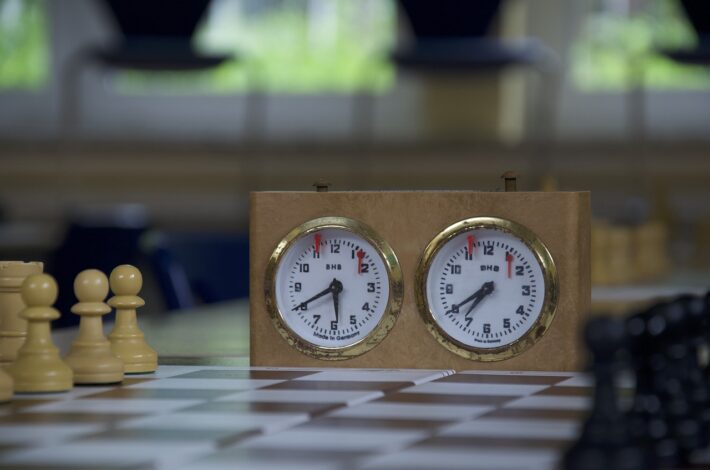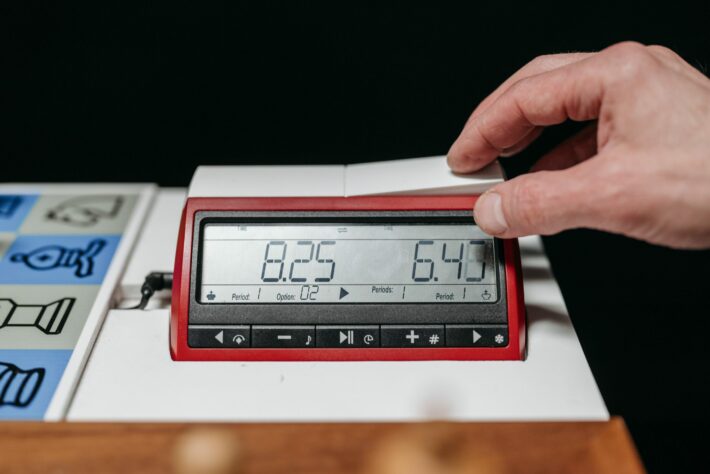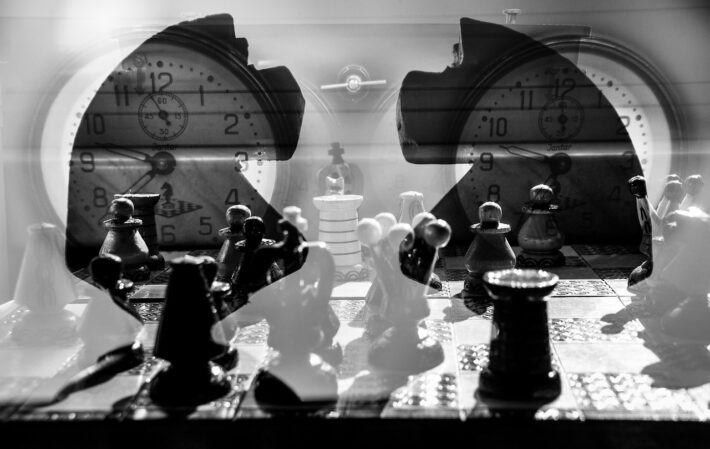Picture yourself engrossed in an intense chess match. Every move is carefully calculated, strategy and skill intertwining in a battle of wits. But have you ever wondered how time management became an integral part of this ancient game?
In this captivating journey through history, we’ll explore the evolution of chess timers, from their humble beginnings to the digital wonders we have today. Discover the impact of analog timers, the dawn of digital innovation, and how these timekeepers have revolutionized competitive chess. Join us as we unravel the Chronicles of Time and explore the captivating world of chess timers!
How did the concept of chess timers originate?
Chess is a game of infinite possibilities, but time adds an element of urgency and decision-making pressure. The need for time management arose in the 19th century, primarily to prevent overly long games.
The first-timers were simple mechanical devices that attempted to solve this challenge. These early timekeepers were inspired by hourglasses, using sand to measure the duration of each player’s turn.
| Time Period | Timer Type | Notable Features |
|---|---|---|
| Pre-20th century | Hourglass | Two connected glass bulbs filled with sand |
| 1950s-1970s | Mechanical Wind-up | Spring-driven mechanism with movable hands |
| 1980s-1990s | Digital Clock | LED or LCD display, push-button functionality |
| 2000s-present | Digital Clock with Delay | Time increment options, delay settings, programmable options |
| Future Possibilities | Smart Timer | Integrated AI assistance, wireless connectivity, customizable interfaces |
What were the first analog chess timers like?

In the early days, chess players relied on analog timers, also known as mechanical chess clocks. These clocks featured a winding mechanism connected to two separate time displays, one for each player.
When a player made a move, they would press a button, and their opponent’s time would start ticking. Analog timers introduced a new dynamic to the game, emphasizing quick thinking and decisive play. The earliest analog timers were rustic and simplistic, yet they laid the foundation for future advancements.
How did analog timers impact chess tournaments?
Analog timers transformed the landscape of chess tournaments, introducing a time-controlled environment that added suspense and thrill. Players had to think faster, make strategic decisions swiftly, and adapt to the ticking seconds.
Chess matches became more engaging for spectators, as they witnessed the pressure mounting on players as their time ticked away. With analog timers, the strategic aspect of time management became an inseparable part of chess tournaments.
What were the limitations of analog timers?
While analog timers were a significant advancement, they did have their limitations. The precision of analog timers depended on the mechanical components and required regular maintenance to function accurately.
Additionally, they were prone to human error, such as forgetting to press the button or accidentally resetting the time. These limitations highlighted the need for a more reliable and efficient timekeeping solution.
When and why did the transition to digital timers begin?
The transition to digital timers began in the late 20th century, driven by the advancements in digital technology. Digital timers offered improved accuracy, ease of use, and additional features that analog timers couldn’t match.
The desire for more precise time management in chess games led to the development of digital timers that could accurately measure every second, making it easier for players and tournament organizers alike.
What technological advancements led to the development of digital chess timers?

The rise of microprocessors and electronic components opened up new possibilities for chess timers. These technological advancements allowed for the creation of digital clocks with LED or LCDs, making time tracking more precise and visible to players and spectators. The use of microcontrollers enabled the addition of features like countdowns, time increments, and programmable settings, enhancing the overall experience of playing with a timer.
How did digital timers revolutionize competitive chess?
Digital timers brought a new level of accuracy, convenience, and fairness to competitive chess. Players could now rely on precise time measurements, eliminating disputes and controversies that often arose with analog timers.
The introduction of time increments also provided players with additional thinking time after each move, promoting deeper analysis and strategic planning. Digital timers reshaped the chess landscape and became an indispensable tool for players, organizers, and spectators.
What features do modern digital chess timers offer?
Modern digital chess timers offer a range of features that enhance the playing experience and provide accurate time management in chess games. These features include:
-
Customizable Time Controls: Players can set specific time limits and adjust them according to their preferences, allowing for flexible game setups.
-
Time Increments: Digital timers offer the option of time increments, providing additional thinking time after each move. This promotes deeper analysis and strategic planning.
-
Delay Settings: Many digital timers have delay settings, which allow players to set a buffer time before their clock starts ticking. This gives players a chance to gather their thoughts before making their moves.
-
Move Counters: Digital timers often include move counters, which keep track of the number of moves made by each player. This can be helpful for players who want to keep track of their progress during the game.
-
Sound Effects: Some digital timers have sound effects that indicate when a player’s time is running out or when the game is over. These auditory cues add an element of excitement and urgency to the game.
-
Memory Functions: Digital timers often have memory functions that allow players to save and recall specific time control settings. This makes it easier to set up games with specific time limits without having to manually adjust the timer each time.
-
User-Friendly Interfaces: Modern digital timers feature user-friendly interfaces with clear displays and intuitive controls. This makes them easy to use for players of all skill levels.
-
Battery Life and Power Saving Features: Digital timers typically have efficient power consumption and long battery life. Some timers also include power-saving features such as automatic shut-off after a period of inactivity, prolonging the battery life.
Are analog timers still used in any chess tournaments today?
While digital timers have become the norm in most chess tournaments, there are still occasional instances where analog timers are used. Some chess organizations and clubs prefer the nostalgic feel and simplicity of analog timers, choosing to preserve the traditional aspects of the game. However, the majority of competitive chess events have embraced the advantages offered by digital timers, ensuring accurate time management and smooth gameplay.
What are the advantages of using digital timers over analog ones?
Digital timers offer several advantages over their analog counterparts. They provide precise time measurement, reducing disputes and ensuring fair gameplay.
The inclusion of time increments allows players to maintain a consistent rhythm and make well-thought-out moves. Digital timers are also more reliable, requiring less maintenance and offering additional features for customization. With digital timers, players can focus on the strategic aspects of chess without worrying about timekeeping issues.
How do digital timers enhance fairness and accuracy in chess games?
Digital timers eliminate human error and provide an objective measurement of time. By automatically tracking and displaying the remaining time for each player, digital timers remove any ambiguity or subjectivity from time management.
This enhances fairness and ensures that both players have an equal opportunity to strategize and make their moves within the allotted time. The precision of digital timers adds an extra layer of excitement and intensity to competitive chess games.
What impact have digital timers had on chess strategy and gameplay?
The introduction of digital timers has influenced chess strategy and gameplay in significant ways. With the pressure of time constantly ticking away, players must think more quickly and make decisions efficiently.
Time management has become an integral part of strategic planning, forcing players to balance between taking the time to calculate their moves and maintaining a quick pace. Digital timers have reshaped the way chess is played, encouraging dynamic and adaptive thinking.
Have there been any controversies or debates surrounding digital timers?

As with any technological advancement, the introduction of digital timers sparked debates and controversies within the chess community. Some argued that digital timers shifted the focus too heavily on speed rather than depth of analysis, potentially sacrificing the traditional aspects of the game. However, the advantages provided by digital timers in terms of fairness, precision, and convenience have largely overshadowed these debates, making them an essential tool for modern chess competitions.
Are there any innovative designs or concepts for future chess timers?
The world of chess timers continues to evolve, with innovative designs and concepts emerging. One intriguing concept is the development of smart timers, equipped with integrated AI assistance to analyze the game and provide real-time feedback.
Wireless connectivity could enable seamless synchronization between clocks and tournament management systems. Customizable interfaces and interactive displays might further enhance the user experience, making chess timers not only functional but also visually appealing.
How might the evolution of chess timers continue in the future?
The evolution of chess timers is likely to continue hand in hand with technological advancements. We can expect even more precise time measurements, smarter features, and seamless integration with digital platforms.
The use of artificial intelligence may further enhance analysis capabilities, providing players with valuable insights and post-game analysis. The future of chess timers holds great potential to enrich the chess-playing experience, ensuring fair competition and stimulating gameplay.
Wrap-up: The Timeless Legacy of Chess Timers
As we conclude our journey through the Chronicles of Time, we see how chess timers have shaped the game and its competitive landscape. From the humble beginnings of analog timers to the digital wonders of today, these timekeeping devices have become an essential part of chess strategy and gameplay. Digital timers have revolutionized the way we approach time management, ensuring fairness, precision, and enhanced gameplay experiences.
As technology continues to advance, the future of chess timers holds exciting possibilities, promising to enrich the timeless game of chess. So next time you sit down to play a game of chess, remember the significance of time and the captivating evolution of chess timers that accompany this ancient game of intellect and skill.




